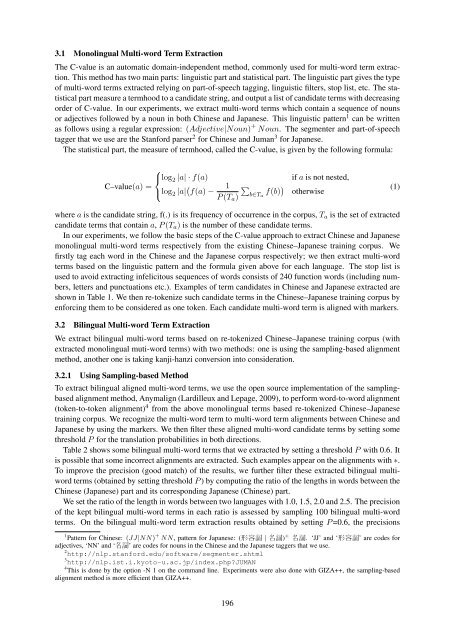December 11-16 2016 Osaka Japan
W16-46
W16-46
You also want an ePaper? Increase the reach of your titles
YUMPU automatically turns print PDFs into web optimized ePapers that Google loves.
3.1 Monolingual Multi-word Term Extraction<br />
The C-value is an automatic domain-independent method, commonly used for multi-word term extraction.<br />
This method has two main parts: linguistic part and statistical part. The linguistic part gives the type<br />
of multi-word terms extracted relying on part-of-speech tagging, linguistic filters, stop list, etc. The statistical<br />
part measure a termhood to a candidate string, and output a list of candidate terms with decreasing<br />
order of C-value. In our experiments, we extract multi-word terms which contain a sequence of nouns<br />
or adjectives followed by a noun in both Chinese and <strong>Japan</strong>ese. This linguistic pattern 1 can be written<br />
as follows using a regular expression: (Adjective|Noun) + Noun. The segmenter and part-of-speech<br />
tagger that we use are the Stanford parser 2 for Chinese and Juman 3 for <strong>Japan</strong>ese.<br />
The statistical part, the measure of termhood, called the C-value, is given by the following formula:<br />
⎧<br />
⎨log 2 |a| · f(a)<br />
C–value(a) =<br />
⎩log 2 |a| ( f(a) − 1<br />
P (T a )<br />
∑<br />
b∈T a<br />
f(b) )<br />
if a is not nested,<br />
otherwise<br />
(1)<br />
where a is the candidate string, f(.) is its frequency of occurrence in the corpus, T a is the set of extracted<br />
candidate terms that contain a, P (T a ) is the number of these candidate terms.<br />
In our experiments, we follow the basic steps of the C-value approach to extract Chinese and <strong>Japan</strong>ese<br />
monolingual multi-word terms respectively from the existing Chinese–<strong>Japan</strong>ese training corpus. We<br />
firstly tag each word in the Chinese and the <strong>Japan</strong>ese corpus respectively; we then extract multi-word<br />
terms based on the linguistic pattern and the formula given above for each language. The stop list is<br />
used to avoid extracting infelicitous sequences of words consists of 240 function words (including numbers,<br />
letters and punctuations etc.). Examples of term candidates in Chinese and <strong>Japan</strong>ese extracted are<br />
shown in Table 1. We then re-tokenize such candidate terms in the Chinese–<strong>Japan</strong>ese training corpus by<br />
enforcing them to be considered as one token. Each candidate multi-word term is aligned with markers.<br />
3.2 Bilingual Multi-word Term Extraction<br />
We extract bilingual multi-word terms based on re-tokenized Chinese–<strong>Japan</strong>ese training corpus (with<br />
extracted monolingual muti-word terms) with two methods: one is using the sampling-based alignment<br />
method, another one is taking kanji-hanzi conversion into consideration.<br />
3.2.1 Using Sampling-based Method<br />
To extract bilingual aligned multi-word terms, we use the open source implementation of the samplingbased<br />
alignment method, Anymalign (Lardilleux and Lepage, 2009), to perform word-to-word alignment<br />
(token-to-token alignment) 4 from the above monolingual terms based re-tokenized Chinese–<strong>Japan</strong>ese<br />
training corpus. We recognize the multi-word term to multi-word term alignments between Chinese and<br />
<strong>Japan</strong>ese by using the markers. We then filter these aligned multi-word candidate terms by setting some<br />
threshold P for the translation probabilities in both directions.<br />
Table 2 shows some bilingual multi-word terms that we extracted by setting a threshold P with 0.6. It<br />
is possible that some incorrect alignments are extracted. Such examples appear on the alignments with ∗.<br />
To improve the precision (good match) of the results, we further filter these extracted bilingual multiword<br />
terms (obtained by setting threshold P ) by computing the ratio of the lengths in words between the<br />
Chinese (<strong>Japan</strong>ese) part and its corresponding <strong>Japan</strong>ese (Chinese) part.<br />
We set the ratio of the length in words between two languages with 1.0, 1.5, 2.0 and 2.5. The precision<br />
of the kept bilingual multi-word terms in each ratio is assessed by sampling 100 bilingual multi-word<br />
terms. On the bilingual multi-word term extraction results obtained by setting P =0.6, the precisions<br />
1 Pattern for Chinese: (JJ|NN) + NN, pattern for <strong>Japan</strong>ese: ( 形 容 詞 | 名 詞 ) + 名 詞 . ‘JJ’ and ‘ 形 容 詞 ’ are codes for<br />
adjectives, ‘NN’ and ‘ 名 詞 ’ are codes for nouns in the Chinese and the <strong>Japan</strong>ese taggers that we use.<br />
2 http://nlp.stanford.edu/software/segmenter.shtml<br />
3 http://nlp.ist.i.kyoto-u.ac.jp/index.php?JUMAN<br />
4 This is done by the option -N 1 on the command line. Experiments were also done with GIZA++, the sampling-based<br />
alignment method is more efficient than GIZA++.<br />
196



